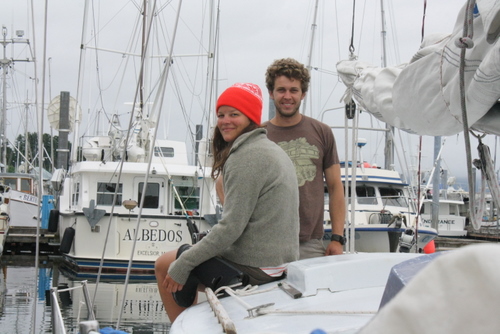
Joanna Nasvik and David Leggitt are part of Coastal Footprint, a Juneau organization conducting beach cleanups in Sitka Sound and along parts of the outer coast. They’re seen here aboard the 29-foot sloop “Swifter,” docked at Eliason Harbor on July 19. (KCAW photo by Ed Ronco)
A nonprofit organization that conducted beach cleanups along the entire North American west coast three years ago is at it again, this time closer to Sitka.
Coastal Footprint was started in 2010 by Louis Hoock. He made a stop in Sitka in his sailboat as he headed south toward the Panama Canal. Now, the nonprofit is in the hands of a Juneau man who’s spending the better part of the summer focusing on beaches near Sitka.
By his own admission, David Leggitt was not born to sail.
He grew up in LA and didn’t spend much time around the ocean. It’s the second part of his job that comes much more naturally. As a child on family camping trips, no one left until a good amount of trash — theirs and others — had been collected.
That’s his mission now: Part one, sailing around in his 29-foot sloop, the Swifter and, part two, picking up garbage from beaches, primarily, large chunks of styrofoam, large fishing floats and a lot of water bottles.
Leggitt runs “Coastal Footprint,” a Juneau-based nonprofit that’s done this once before. In 2010, the organization traveled the entire west coast of North America. But that was before the 2011 Japanese tsunami, which sent millions of tons of debris into the Pacific Ocean.
Its often hard to say whether Leggitt and his crew are picking up Japanese tsunami debris. He says some of what they find has Asian characters on it, but that he doesn’t speak any of those languages to know for sure. That said, he knows the debris is changing, at least anecdotally.
“Talking to the locals who are spending a lot of time out there, they’re noticing a lot of new kinds of debris that they haven’t seen before,” Leggitt said. “Large chunks of styrofoam, maybe six feet long and four feet across. Huge. And that’s a new thing that they’ve been seeing — wrapped in tarps, or some kind of plastic.”
Leggitt says getting the debris off the beach is one thing, but getting it back to town for proper disposal is another.
“We fit stuff inside in one of the spare quarter berths, we fit stuff in the lockers in the cockpit,” he said. “Then the big stuff, we just strap it on the deck. It makes sailing a little bit interesting at times, trying to climb around on big chunks of styrofoam. We just float it up and bring back what we can.”
A lot of the debris in the ocean begins to break down as it’s exposed to sunlight and the elements. For example, as things like plastics degrade, they turn into tiny little bits.
“These animals consume the plastics and they get into their digestive systems, and they can’t digest it, and it just sits there,” Leggitt said. “Then the animal feels full and doesn’t need to eat.”
They’ve found foam and bottles, tarps and pieces of plastic. Leggitt says what they’re doing is really important for the local environment, but also:
“It’s a total adventure,” he said. “I get to go sail around and see all these new spots and do something good at the same time, and take friends out, and do something good for the community.”
One of those friends is Joanna Nasvik, from Missoula, Montana.
“I met David last fall through a friend traveling in California,” Nasvik said.
Nasvik, as it turned out, has some relevant experience to Coastal Footprint’s mission.
“In Missoula, I host town cleanups and try to recruit people from the community to come out and pick up certain areas,” she said. “It was right up my alley, and I always wanted to come to Alaska, so I thought that would be the way to do it.”
Nasvik and Leggitt have focused on Sea Lion Cove, along the outer coast of Kruzof Island, and the beaches near Goddard Hot Springs. They’ve also been to Etolin Island and Herring Cove.
Coastal Footprint plans cleanup trips through mid-August.































